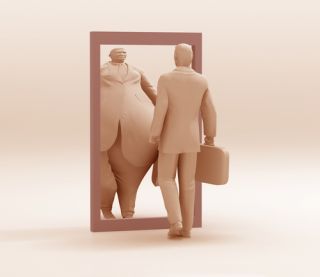Body Image
Male AN and Body Image
Males with AN experience a painfully distorted body image.
Posted February 11, 2013

“The first thing I want you to know” Jeremy said, “is that I hate my body.” As I strained to hear these words, spoken by a frail 16-year-old boy, I was struck by the intensity in his voice, in spite of its softness.
Early in our work together, Jeremy and I frequently talked about his “ideal” body. With his artistic talents in mind, I asked Jeremy to draw a picture of what that ideal body might look like. When he brought the picture to our next session, I was surprised to find that it appeared quite reasonable, not unlike what I imagined most young men might envision.
For our next session, Jeremy brought a drawing of his "real body." In contrast to the painfully thin boy sitting before me, the drawing showed a thin boy with an enormous and round stomach drooping over his belt. In our ensuing discussion, Jeremy and I discovered that it wasn't so much his ideal body that was problematic; on the contrary, his body image was painfully out of sync with reality. This began Jeremy's long journey toward developing a more realistic perception of his own body.
In The Image and Appearance of the Human Body (1950), Paul Schilder was the first to consider bodily experience from a psychological and sociological point of view. Previous research focused on distortions in body perception caused by brain damage. In contrast, Schilder defined body image as the picture of ourselves we form in our own minds.
Body image is subjective. In some cases, there is little correlation between one’s subjective experience of the body and its appearance to an outside observer. Although Jeremy appeared very thin and frail to others, he experienced his body as large and misproportioned.
In fact, some research supports Jeremy's experience. In one study, researchers asked males to choose, among 100 possible images with 10 different levels of muscularity and 10 levels of fat, (1) his own body, (2) the body he would like to have, (3) the body of an average man his age, and (4) the male body he believed women would like best. The body ideals of males with AN were no different than the body ideals of healthy subjects. However, these males perceived themselves as almost twice as fat as they actually were (Mangweth et al., 2004).
If this finding is robust, males with eating disorders may not need re-education about the levels of body fat that are reasonable and appropriate. On the contrary, it may be that their perceptions of their bodies, or their body images, require revision.
Sources:
Mangweth, B., Hausmann, A., Walch, T., Hotter, A., Rupp, C. I., Biebl, W., et al. (2004). Body fat perception in eating-disordered men. International Journal of Eating Disorders, 35, 102-108.


